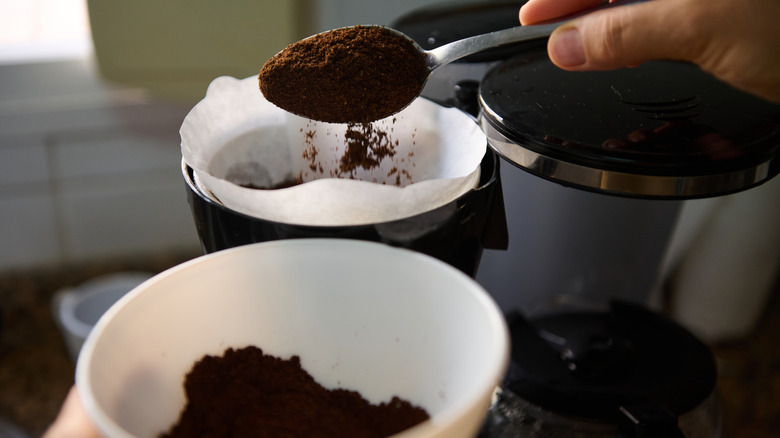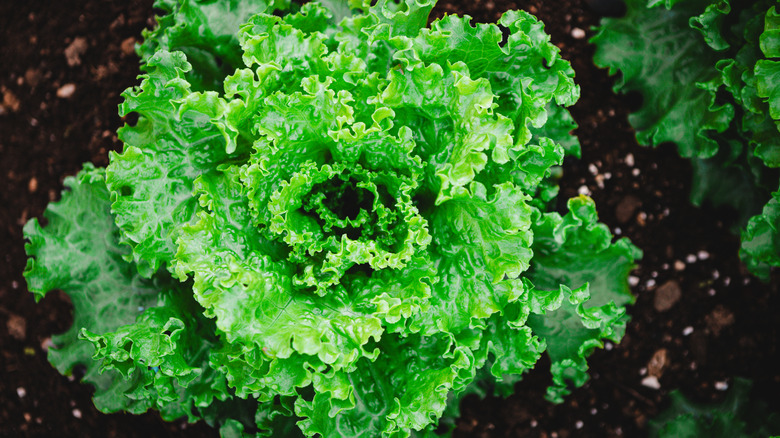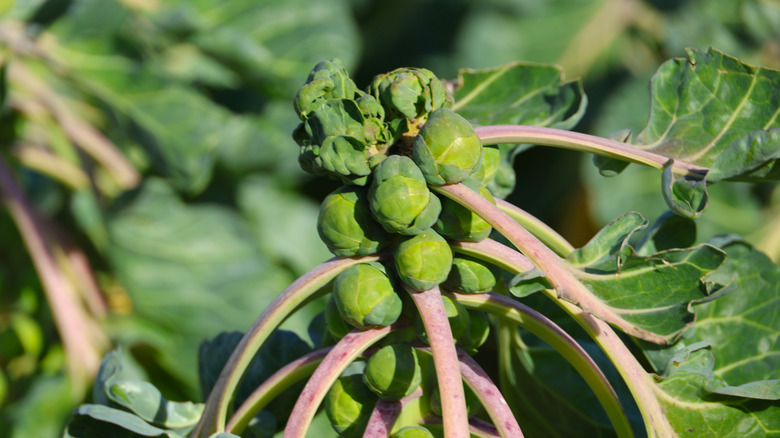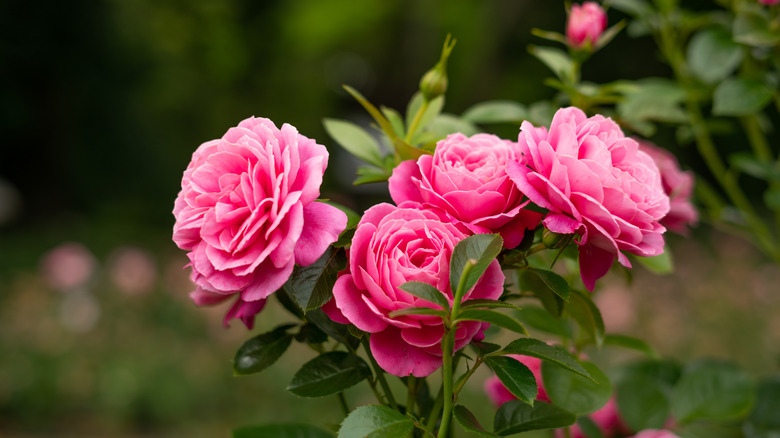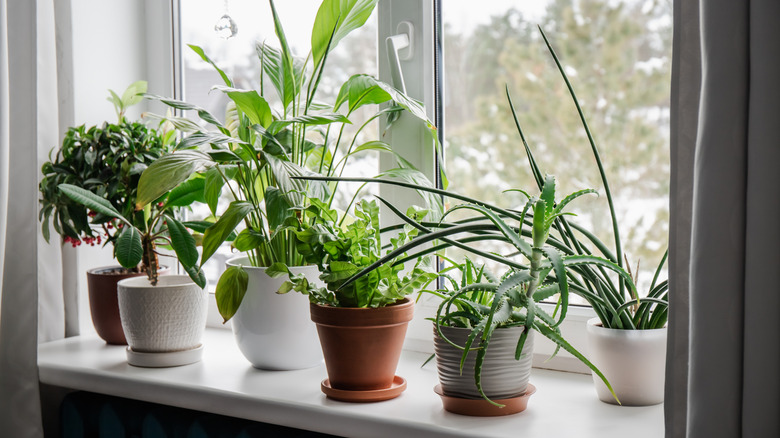Don't Toss Coffee Grounds- Here Are 10 Fall Plants That Benefit From The Kitchen Scrap
Can the coffee lovers step to the front, please? Brewing your daily cup (or cups, no judgment) at home comes with a host of benefits, and if you're a gardener, you might be missing out on one of the best perks. Every time you toss your spent coffee grounds, you're unknowingly throwing out brown gold. Instead of disposing of your grounds, put them to work in the garden this fall. Coffee grounds contain carbon, nitrogen, and other elements that beneficial soil organisms love to feed on. They also aid in keeping less-than-desirable microbes away.
Sprinkling or mixing this kitchen waste with your plant soil is a genius way to use leftover coffee grounds in your garden this fall. However, this hack does come with a caveat. Some gardeners claim coffee grounds lower pH levels in the soil. While coffee is slightly acidic, it won't move the needle enough to support plants that crave acidic soil. Coffee grounds really shine in improving soil composition, suppressing weeds, and deterring pests such as slugs. Plants such as kale, violas, and carrots can all benefit from coffee grounds in your garden this fall.
Kale
Kale (Brassica oleracea var. acephala) is a popular cold-hardy superfood you can grow in the garden well into fall and even through the winter in mild regions. Kale thrives in rich, nitrogen-heavy soil. Coffee grounds can bolster the nitrogen levels in your soil, helping your kale to produce lush growth. Side-dress your plants with coffee grounds mixed with compost throughout the fall for the best results.
Lettuce
From romaine to butterhead, all types of lettuce (Lactuca sativa) can benefit from adding coffee grounds to their soil. Lettuce thrives in colder temperatures, producing a sweeter yield in the fall. Just like kale, this crop is a heavy nitrogen feeder. Coffee grounds mixed with compost or alfalfa meal can help provide supplemental nitrogen. Lettuce is also susceptible to slugs, so coffee grounds help keep them at bay.
Broccoli
Broccoli (Brassica oleracea) is another classic cold-weather crop that you'll often see growing late into fall. This veggie thrives on the nitrogen, phosphorus, and potassium deposited by coffee grounds. The coarse texture of the grounds also encourages improved drainage, aiding in better water absorption so your broccoli stays hydrated. Just make sure you rake them into the soil a little so they don't become compacted. Slugs and other creepy crawlies also love to munch on broccoli, and coffee grounds help to keep them away.
Carrots
Root vegetables such as carrots (Daucus carota subsp. sativus) grow well in the fall. But they tend to require a lot of water – up to 1 inch a week in some cases. You can give the carrots in your garden a serious boost by incorporating coffee grounds into your soil. The coffee grounds can improve moisture retention, keeping your carrots hydrated. You can also extract more of the beneficial compounds in the grounds by composting them first. Allow the grounds to decompose with one part coffee grounds, one part fresh green clippings, and three parts dead leaves.
Brussels sprouts
Brussels sprouts (Brassica oleracea) are another cold-season veggie you should consider amending with coffee grounds. The best yields require plenty of moisture as the sprouts develop. Coffee grounds aid in bolstering water retention while also improving the soil texture. Be sure to mix them into the soil well for the best results. This offers a better growing medium for tastier, more abundant Brussels sprouts.
Violas
If you're looking for a lovely bloom that's tough enough to weather the cool days of fall, look no further than the pansy (Viola x wittrockiana). These charming, colorful blooms offer a beautiful display even into the winter, making them a popular option for containers and borders. Pansies thrive in moist soil, so they're another great candidate for supplemental coffee ground use. Slugs are also a common pest for pansies, so the coffee grounds will keep them at bay, too.
Hydrangeas
While hydrangeas (Hydrangea spp.) are typically just about to enter their dormancy period in the fall, they can still benefit from coffee grounds in this season. Many old-growth hydrangeas set summer flower buds in the fall before they go dormant. The nitrogen, phosphorus, and potassium in coffee grounds help get your hydrangeas to the finish line as they do the last of their growing before winter. This can set the groundwork for more vibrant, healthy blooms in the next growing season.
Canna lilies
Canna lilies (Canna x generalis) are vibrant perennial flowers that, despite their tropical appearance, can grow abundantly in many parts of the United States. They can bloom from summer all the way to the first frost if diligently tended to. Canna lilies love rich, moist soil, so coffee grounds are a great supplemental amendment you can use to support your plants through fall.
Roses
It's tricky work growing roses (Rosa spp.). Some varieties can bloom all the way into fall if well-tended. These classic beauties require a lot of water to thrive. But you can't drown them either. Coffee grounds help you strike the perfect balance, retaining water nicely while also not allowing it to pool around the plant. Coffee grounds can also add supplemental nutrients to your roses. Sprinkle the grounds around your plant and top them off with mulch, such as wood chips or dead leaves, for even more nutritional value.
Indoor plants
Don't forget about your houseplants! You can give these plants coffee grounds to help them thrive, too. While they're not technically "fall plants", they still go through their own cycles with the seasons — especially if you bring them outside for the warmer seasons. After a long summer of growing outdoors, the soil can become compacted. Repotting and incorporating small amounts of composted coffee grounds into the mix before bringing your plants inside can increase aeration and soil composition. Add coffee grounds to houseplants such as peace lilies, snake plants, and Christmas cactus.
